Boy Scout Troop 4 restores St. Helena lighthouse station to ship shape
Editor's note: Pam Stout, Community Assistant at AnnArbor.com, has two sons in Boy Scout Troop 4 and is a member of First United Methodist of Ann Arbor, where the troop is based. She wrote this story as a participant on this trip with her family.
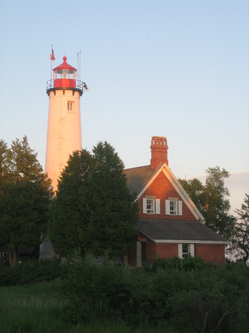
Pam Stout | AnnArbor.com
During the last week in June, the usually uninhabited St. Helena Island in the Mackinac Straits was bustling with activity. A total of 55 Boy Scouts, leaders, and siblings were hauling, washing, weeding, building and renovating the historic lighthouse, buildings and nature area with a decidedly youthful spirit.
At the first group meeting at the foot of the lighthouse tower, adult leader Ron McCready asked, "What are we here to do?"
After a brief pause, a veteran St. Helena scout answered, “Cheerful service!”
Since 1989, the Boy Scouts from Ann Arbor's Troop 4 have journeyed to St. Helena Island at the beginning of summer vacation to restore and maintain the historic lighthouse. Troop 4, with more than 50 members ages 10- to 18-year-old, holds its meetings at First United Methodist Church of Ann Arbor.
The venture began as a glimmer in the eye of Dick Moehl, a national advocate for lighthouse preservation, in the early 80s. The St. Helena lighthouse station, a beacon that has helped ships traverse the Straits of Mackinac since 1873, had deteriorated badly after decades of neglect, weather and vandalism. The keeper's house roof was reduced to rafters, fires had destroyed multiple levels of flooring, and the lantern had been smashed to the ground, among other problems. A 1980 Coast Guard survey recommended razing all but the lighthouse tower.
That's when Moehl took action to preserve the historic property. He helped create the Great Lakes Lighthouse Keeper's Association (GLLKA) with a mission calling for "the preservation of lighthouses, the stories of those who kept them, and developing a new generation of preservationists."
GLLKA obtained a license to restore the light station from the Coast Guard in 1986. The group then lobbied Congress and fellow lighthouse advocates to update legislation and create the $3 million National Bicentennial Lighthouse Fund to provide matching grants for over 160 lighthouse preservation projects. The matching could be designated through financial pledges and in-kind contributions.
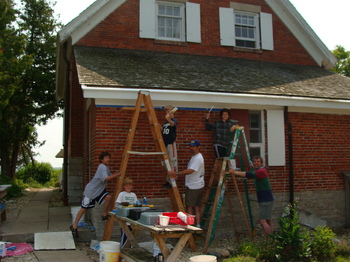
Members of Boy Scout Troop 4 and their families touch up the St. Helena lighthouse. From L to R: Jordan Silvester, David Debacker, William Collicott, Brad Silvester, Patrick McKee and Shawn McKee.
Photo courtesy of Dick Moehl
Eagle projects with impact
The most prestigious award that a Boy Scout can earn is that of the rank of Eagle Scout. Only about two in 100 scouts earn this rank. A requirement to obtain this rank is the carrying out of a Eagle leadership project. To date, 26 Eagle projects have been completed at St. Helena. The first project in 1989 provided a suitable home for displaced Ospreys who had taken up residence atop the lighthouse tower prior to the rebuild of the lantern room. The project involved the construction of two nesting platforms, 20 feet-tall, for the Ospreys, signifying respect for the island's natural environment.
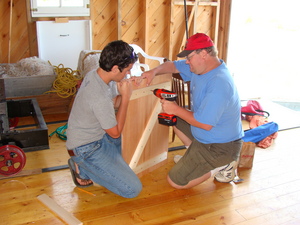
Nicholas Wardner and Duane Collicott work on Wardner's Eagle project in the St. Helena boathouse.
Photo courtesy of Dick Moehl
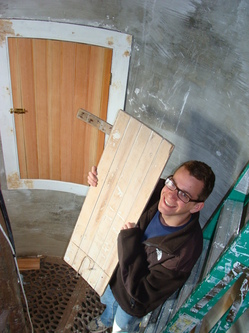
Jake Levine shows off his curved cabinets inside the lighthouse
Photo courtesy of Dick Moehl
Jake Levine, 15, rebuilt four window frames and three cabinets in the lighthouse tower. The original window frames, badly dilapidated, had to be completely replaced. Because of the tower’s sloped and circular walls, each piece was custom cut to fit significant curves and bumps. Levine and his team worked on the steep iron spiral staircase as they installed each piece.
The rest of the troop helped with the Eagle projects as well as power washing, painting, maintaining, landscaping or working on scout advancement tasks. In one week in June, a total of 55 family members contributed more than 1,965 labor hours toward historic preservation of the lighthouse station and its surroundings.
Working at St. Helena
The island's isolation and minor hardships instill a sense of camaraderie for those who work on the island. True to its history, the island is reachable only by boat and still has hand-dug latrines, water from a hand-pumped well, and no electricity. Schedules follow the rhythm of nature and weather, not manageable by human technology. GLLKA has made use of this nostalgic setting by offering tours and volunteer experiences for those who would like to spend a day — or a week — going "back in time" on St. Helena Island.
The Scouts have engineered simple conveniences to make the island stay a little bit easier, such as a propane system providing hot outdoor showers. Food is cooked in a propane oven in the "summer kitchen" of the keeper's house. Guests are called to meals via the toll of an old iron bell heard easily throughout the camping area.
For the boys, St. Helena is a rich tradition they look forward to year after year. Nicholas Wardner has spent eight seasons on the island. According to Wardner, the week at St. Helena is a great time to get to know people without the distractions of modern life. "Even though there isn't that much to do during free time," he said, "everything here is a novelty. You can sit on the dock, skip rocks. . . or just learn to whistle."
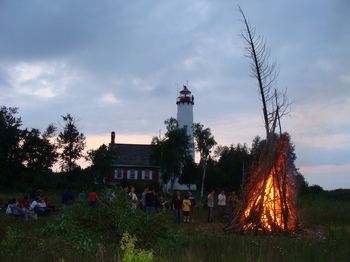
Photo courtesy of Dick Moehl
Find more information about Troop 4 at its website. For information about the St. Helena Lighthouse Station or the Great Lakes Lighthouse Keeper’s Association, go to http://www.gllka.com or contact Dick Moehl at info@gllka.com.


Comments
Duane Collicott
Thu, Jul 15, 2010 : 9:04 a.m.
@81wolverine - there are also a lot of Great Blue Herons that nest there. They fly over from the U. P. to nest there. You would need a boat, of course, and walk through some tough undergrowth to see it, but it's a great sight.
Sandy
Thu, Jul 15, 2010 : 6:39 a.m.
Kudos to the young men, the troop leaders, and the family members who dedicated time and energy for such a worthy cause! Boy Scouts of America is a great way to teach these boys to become upstanding citizens of the world - to rise above the expectations put upon them in todays society. Great job, Troop 4!
81wolverine
Wed, Jul 14, 2010 : 2:08 p.m.
As a bird lover, I'm glad to hear that new Osprey nesting sites were created to replace the old one. Osprey's are not nearly as abundant on the Great Lakes as they once were. So, putting up platforms for them to build nests upon will really help. This method works very well in Florida (and other states) where Osprey's are much more numerous.
Duane Collicott
Wed, Jul 14, 2010 : 2:07 p.m.
A lot of work is done up there, and it's much harder than in your own workshop at home. We can only work when the generator is running (and try to remember to charge our batteries while it's on), we often don't have the exact piece of wood we need and have to rip some other piece down to size on a small table saw, and nails and screws must be used efficiently because we can't just pop down to the hardware store to get more. However, in exchange for all the hard work, there are the benefits of helping with the lighthouse, helping with the growth of the Scouts, and watching the sun rise over the Mackinac Bridge.
Top Cat
Wed, Jul 14, 2010 : 1:42 p.m.
These young men are a credit to our region and our nation. The 13 years I spend as a Scout Leader was one of the best things I've done in my life. This is one more reason why people should support this fine Troop and the Boy Scouts of America.
81wolverine
Wed, Jul 14, 2010 : 11 a.m.
Fascinating and great article! My wife and I own property up in the Mackinaw area and can actually see St. Helena Island and the lighthouse from it. We often wonder about the lighthouse and it's condition, and whether anyone lives on the island. Your article answered our questions! It's very impressive that the troop has gone up there for 21 years. What a fantastic project. Congratulations to everyone involved on a job well done!